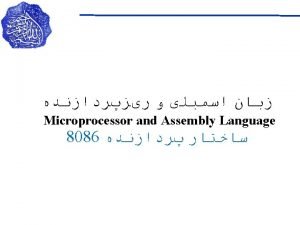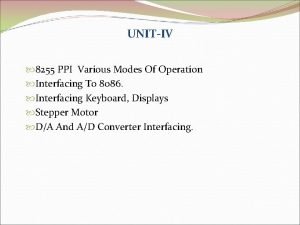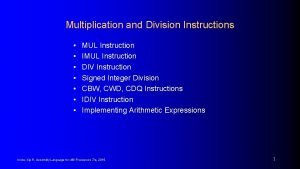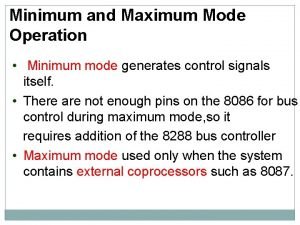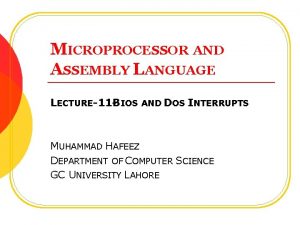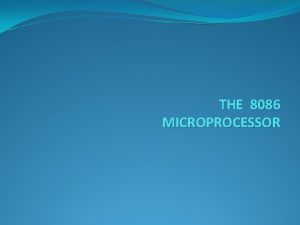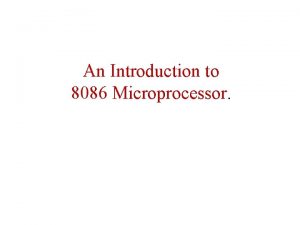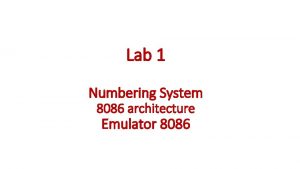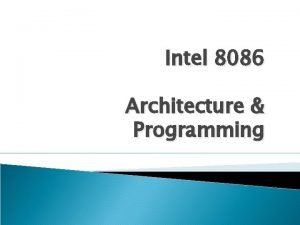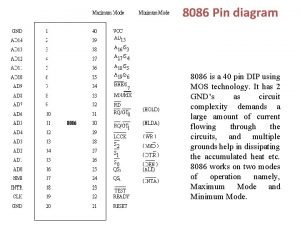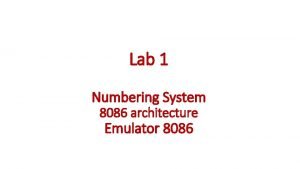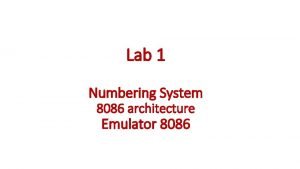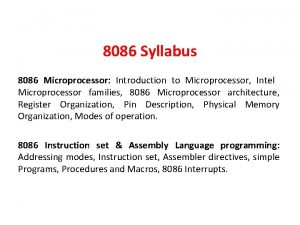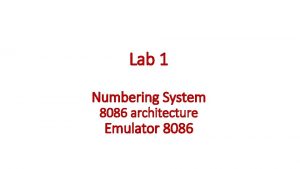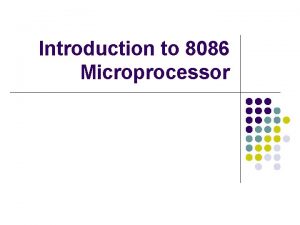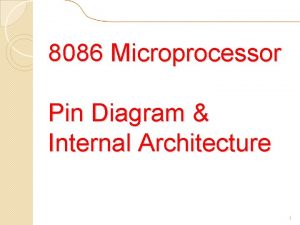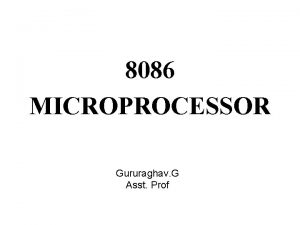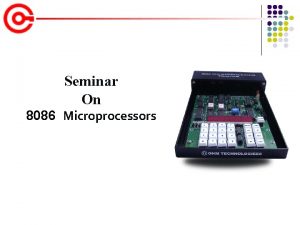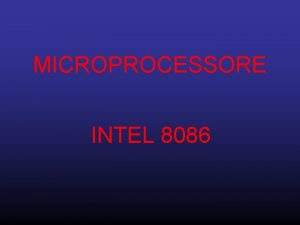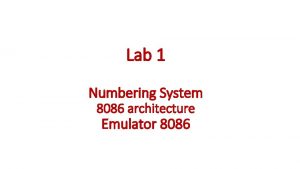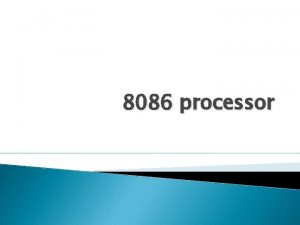8086 History of 80 x 86 Family of























- Slides: 23


8086 History of 80 x 86 Family of Microprocessors • Evolution from 8086 to 8088 8086 was with 16 -bit data bus internally and externally. All registers and the data bus carrying data in/out of the CPU were 16 -bit. That time all the peripherals were designed around 8 -bit microprocessor. So introduced which Intel It was expensive 8088 to built PCBwas; with 16 -bit data bus. Identical to 8086 internally, but externally 8 -bit data bus instead of 16 -bit. It had 1 megabyte of memory like 8086. IBM chosed 8088 as their microprocessor in designing the IBM PC. 8088 -based IBM PC was enormous success, because IBM and Microsoft made it an open system. This enabled the cloning of this system and resulted a huge growth in both hardware and software designs based on IBM PC. In contrast IBMs main competitor Apple computer introduced a closed system and blocked all attempts of cloning.

8086 History of 80 x 86 Family of Microprocessors • Other microprocessors: 80286, 80386, and 80486 80286: Intel introduced 80286 in 1982. With 16 -bit internal and external data bus. 24 -bit address bus (224 = 16 megabyte) Virtual Memory: a way of fooling the microprocessor into thinking that it has access to unlimited memory by swapping data between disk storage and RAM. Real mode (faster operation with maximum of 1 Mbytes of memory) vs. Protected mode protecting the operating system for accidental or deliberate destruction by the user. Protected mode is slower but can use 16 megabytes of memory.

8086 History of 80 x 86 Family of Microprocessors • Other microprocessors: 80286, 80386, and 80486 80386: Introduced in 1985 also known as (80386 DX) With 32 -bit internal and external data bus. 32 -bit address bus (232 = 4 gigabyte-physical memory). With virtual memory 64 terabyte(246). 80386 SX was later introduced with the same internal structure with 16 -bit external data busdiscussed and 24 -bit 80386 SX wasmicroprocessors much cheaper. All microprocessors so address far werebus. general-purpose and could not handle mathematical operations rapidly. For this reason, 8087, 80287, 80387 numeric data processing chips called math co-processors were used. 80486: introduced in 1989 with 32 -bit internal-external data bus and 32 -bit address bus. built in math co-processor in a single chip. Introduction of cache memory ( Static RAM with very fast access time)

8086 History of 80 x 86 Family of Microprocessors • Evolution of Intel's Microprocessors Product 8080 8085 8086 8088 80286 80386 80486 Year Introduced 1974 1976 1978 1979 1982 1985 1989 Clock rate (MHz) 2 -3 3 -8 5 -10 5 -8 6 -16 16 -33 25 -50 No. transistors 4500 6500 29, 000 130, 000 275, 000 1. 2 million Physical memory 64 K 1 M 1 M 16 M 4 G 4 G Internal data bus 8 8 16 16 16 32 32 External data bus 8 8 16 32 32 Address bus 16 16 20 20 24 32 32 Data type (bits) 8 8 8, 16, 32 8, 16, 32







8086 Architecture of 8086 Microprocessor • 8086: Internal Organization, Pipelining, and Registers

8086 • Pipelining Architecture of 8086 Microprocessor In 8085 microprocessor, the CPU could either fetch or execute at a given time. CPU had to fetch an instruction from the memory, then execute it, then fetch again and execute it and so on. Pipelining is the simplest form to allow the CPU to fetch and execute at the same time. Note that the fetch and execute times can be different. Pipelined vs. Nonpipelined Execution

8086 • Architecture of 8086 Pipelining is achieved. Microprocessor by splitting the internal structure of 8088/86 into two sections. the execution unit (EU) the bus interface unit (BIU) These two sections work simultaneously. BIU accesses memory and peripherals while the EU executes the instructions previously fetched. It only works if BIU keeps ahead of EU. Thus BIU has a buffer of queue. (8088 has 4 byte, and 8088 has 6 bytes). If the execution of any instruction takes to long, the BIU is filled to its maximum capacity and busses will stay idle. It starts to fetch again whenever there is 2 -byte room in the queue. When there is a jump instruction, the microprocessor must flush out the queue. When a jump instruction is executed BIU starts to fetch information from the new location in the memory. In this situation EU must wait until the BIU starts to fetch the new instruction. This is known as branch penalty.

8086 • Registers of 8086 Microprocessor In the CPU, registers are used store information temporarily. The information can be one or two bytes of data, or the address of data. In 8088/8086 general-purpose registers can be accessed as either 16 -bit or 8 bit registers. All other registers can be accessed as full 16 -bit registers. The bits of the registers are numbered in descending order: 8 -bit register: MSB LSB 16 -bit register: MSB LSB

8086 Registers of 8086 Different registers are. Microprocessor used for different functions. Registers will be explained later within the context of instructions and their applications. The first letter of each general register indicates its use. AX is used for the accumulator. BX is used for base addressing register. CX is used for counter loop operations. DX is used to point out data in I/O operations. Registers of 8086 General registers can be accessed as full 16 bits (such as AX), or as the







 Intel 80 86
Intel 80 86 Conjugal family
Conjugal family Periodic table families
Periodic table families Blended family vs binuclear
Blended family vs binuclear Temple and family history consultant
Temple and family history consultant Haddara family history
Haddara family history Pedigree chart
Pedigree chart Barnsley family history
Barnsley family history Caribbean family history
Caribbean family history History also history physical
History also history physical Ax 86s
Ax 86s Interrupt vector table 8086
Interrupt vector table 8086 Dac interfacing with 8255
Dac interfacing with 8255 Interfacing adc with 8086
Interfacing adc with 8086 Difference between shr and sar in 8086
Difference between shr and sar in 8086 Immediate addressing mode in 8086
Immediate addressing mode in 8086 Addressing modes of 8086 microprocessor
Addressing modes of 8086 microprocessor Loop instruction in 8086 with example
Loop instruction in 8086 with example Imul assembly
Imul assembly Minimum and maximum mode of 8086
Minimum and maximum mode of 8086 Fibonacci assembly code 8086
Fibonacci assembly code 8086 Language
Language Difference between bios and dos interrupts
Difference between bios and dos interrupts Function of microprocessor
Function of microprocessor
